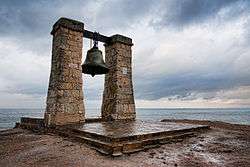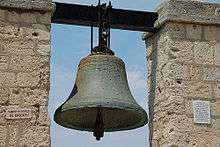Bell of Chersonesos

The Bell of Chersonesos in Chersonesos Taurica, Crimea, Russia/Ukraine[1] is the symbol of Chersonesos and one of the main sights of Sevastopol. It was cast before the foundation of Sevastopol for the Saint Nicholas the Wonderworker Church in Taganrog, which was the Russian Navy's military base at that time. It was later confiscated by the French, then returned.
History
The bell of Chersonesos or the fog bell of Chersonesos is sometimes considered by many as "one of Taganrog's sights located abroad", which even became a symbol of another city - Sevastopol or to be more exact, the symbol of Chersonesos Taurica.
The fog bell was cast in 1778 from the trophy Turkish cannons seized by the Russian Imperial Army during Russo-Turkish War (1768–1774). The bell features depictions of patron saints of sailors: Saint Nicholas and Saint Phocas and the following phrase can still be read today in Russian: «Сей колокол вылит в Святого Николая Чудотворца в Таганро… из пленен Турецкой артиллери… весом … пуд фу (нт) 1778 месяца Августа … числа». , which literary means "This bell was cast in the Saint Nicholas the Wonderworker Church in Taganrog from the trophy Turkish artillery...weight...pounds. Year 1778, month of August, on the day of ...".
The bell was cast before the foundation of Sevastopol for the Saint Nicholas the Wonderworker Church in Taganrog, which was the Russian Navy's military base at that time. Until 1803 the St.Nicholas church was subordinated to the Navy ministry. After Sevastopol became the main Russian military navy base in the South of Russia, the Emperor Alexander I ordered the bell to be transported to Sevastopol to be fitted in the Church of St. Nicholas which was being constructed there, with other bells and church plates also given over to the city of Sevastopol.
During the Crimean War the fog bell was seized by the French and was placed in the cathedral of Notre-Dame of Paris. Many years later, a bell with a Russian inscription was found and finally thanks to diplomatic efforts undertaken by both sides, and especially by the French consul in Sevastopol Louis Ge, the bell was solemnly returned to monastery at Chersonesos on September 13, 1913 and was placed on a temporary wooden belfry near the St.Vladimir Cathedral. The French President Raymond Poincaré in his letter to consul Louis Ge wrote that he returned the bell to Russia "as a sign of alliance and friendship". In their turn, the Russian government awarded the French consul the Order of St. Vladimir of the 4th degree.
The monastery was closed in 1925 by the communist authorities, and two years later all its bells were sent away to be recast. Only one bell escaped this fate because the Department of the Security of Navigation of the Black and Azov Seas proposed to place it on the coast as a signal fog bell. In this capacity the bell served until the 1960s.
Gallery
 The bell of Chersonesos, view on the Black Sea.
The bell of Chersonesos, view on the Black Sea. The bell of Chersonesos, view on the St.Vladimir Cathedral
The bell of Chersonesos, view on the St.Vladimir Cathedral The bell of Chersonesos, close-up
The bell of Chersonesos, close-up Memorial plate with short history of the fog bell
Memorial plate with short history of the fog bell Close-up
Close-up
Trivia
The bell of Chersonesos was featured in the Soviet Russian film for children Priklyucheniya Buratino (The Adventures of Buratino) in 1975.
References
- Encyclopaedia of Taganrog — Ростов-на-Дону: Ростиздат, 2003. — 512 с. — ISBN 5-7509-0662-0.
External links
Coordinates: 44°36′47″N 33°29′31″E / 44.6131°N 33.4920°E
- ↑ This place is located on the Crimean Peninsula, most of which is the subject of a territorial dispute between Russia and Ukraine. According to the political division of Russia, there are federal subjects of the Russian Federation (the Republic of Crimea and the federal city of Sevastopol) located on the peninsula. According to the administrative-territorial division of Ukraine, there are the Ukrainian divisions (the Autonomous Republic of Crimea and the city with special status of Sevastopol) located on the peninsula.